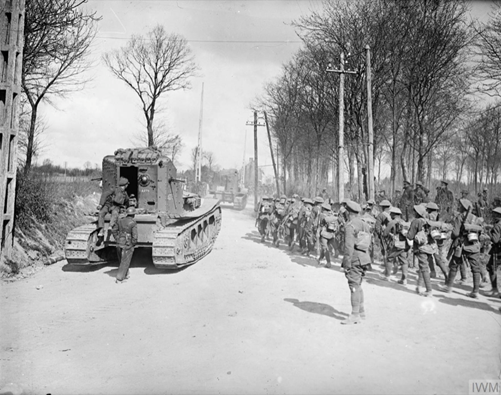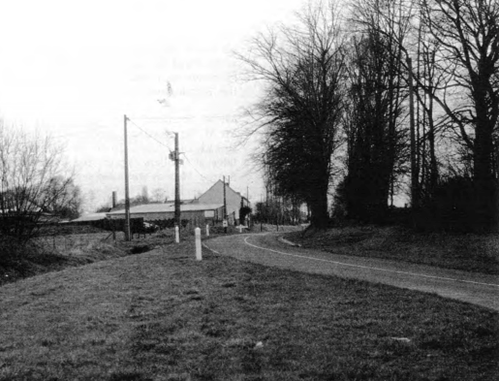The Camera Returns (13) Mailly Maillet by Bob Grundy and Steve Wall
- Home
- World War I Articles
- The Camera Returns (13) Mailly Maillet by Bob Grundy and Steve Wall
[This article first appeared in Stand To! No.31 Spring 1991. Members of The Western Front Association received this magazine three times a year and have access to the entire digital archive online].
 |
||
|
Whippet Tanks of the 3rd Battalion at Maillet-Mailly. The advancing infantry are of the New Zealand Division. © IWM Q 9821 |
||
 |
||
|
The 1990 comparison taken looking north-east towards the village at the now improved junction of the N919 and D176 |
||
 |
||
|
The view courtesy of Google Street view © Google September 2008 |
Taken on the outskirts of Mailly Maillet, IWM photo Q9821 shows Whippet tanks of the 3rd (Light) Tank Battalion entering the village on 26 March 1918, five days after the start of the German spring offensive. New Zealand troops, who were to see action later in the day, can be seen marching in file on the right. Although never captured by the enemy, Mailly Maillet was in continuous use by troops resting from the front line. The house on the left was an estaminet used by them. Both Edmund Blunden and Frederic Manning mention their stays in the village and woods in their respective books, Undertones of War, and The Middle Parts of Fortune.
Only the 3rd Tank's C Company (Capt T. F. Price, DSO, MC) were in Mailly Maillet on the 26th. Comprising four sections each of four tanks, they had journeyed from the tankodrome on the Albert—Bray road the previous day. After replenishing with petrol from a dump at the southern comer of Mailly Maillet Wood on the morning of the 26th, they proceeded to Colincamps, arriving there at midday. As the tanks shown in the photograph are moving north-east, we believe that they are in fact en route for Colincamps. After entering that village, C Company was quickly ordered out to confront a mass of German infantry. These unfortunates were routed and prevented from entering the village. Half of C Company was kept outside the village to dominate the ground until the arrival of the New Zealanders later in the afternoon. This was the first occasion on which Whippets had been used in action and compared with the first attack of the heavy tanks in 1916, was an undoubted success.
The Whippet tank was at first known as the 'Triton Chaser' after its designer, Sir William Triton. Later officially named Tank Medium Mark A, they were intended to cooperate with the cavalry in open warfare, but this was found to be impracticable. The horse was faster but unarmoured: the tank was slower (max 8 mph) but armoured and impervious to small arms fire. A total of 200 Whippets were produced and many sterling deeds were accomplished with them, notably by Lt Col West and Lts Arnold and Sewell who were awarded VCs. Two of the three .303 Hotchkiss machine guns can be seen protruding from the sides of the cab or turret which did not rotate. As is the case here, the fourth Hotchkiss was not usually mounted so as to give more room in the cramped interior. One of the crewmen is walking at the rear of the tank as this would be preferred to the hot and noisy ride inside. On the roof can be seen 'spuds'. These could be fitted to some of the track plates to provide extra traction over rough ground. The evidence of their use is slim as we have found no photograph of them fitted except on the prototype.
The location of this photograph is easy to find. Our 1990 comparison was taken looking north-east towards the village at the now improved junction of the N919 and D176 This is a fascinating photograph, full of detail. For example, the Lewis gun magazine holder carried by the third soldier from the right, and the spoon stuck in the puttee of the man nearest the camera.





